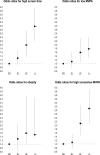Sleep duration or bedtime? Exploring the relationship between sleep habits and weight status and activity patterns
- PMID: 21966061
- PMCID: PMC3174832
- DOI: 10.5665/SLEEP.1266
Sleep duration or bedtime? Exploring the relationship between sleep habits and weight status and activity patterns
Abstract
Study objectives: To assess the effects of early and late bedtimes and wake up times on use of time and weight status in Australian school-aged children.
Design: Observational cross-sectional study involving use of time interviews and pedometers.
Setting: Free-living Australian adolescents.
Participants: 2200 9- to 16-year-olds from all states of Australia
Interventions: NA.
Measurements and results: Bedtimes and wake times were adjusted for age and sex and classified as early or late using median splits. Adolescents were allocated into 4 sleep-wake pattern groups: Early-bed/Early-rise; Early-bed/Late-rise; Late-bed/Early-rise; Late-bed/Late-rise. The groups were compared for use of time (screen time, physical activity, and study-related time), sociodemographic characteristics, and weight status. Adolescents in the Late-bed/Late-rise category experienced 48 min/d more screen time and 27 min less moderate-to-vigorous physical activity (MVPA) (P<0.0001) than adolescents in the Early-bed/Early-rise category, in spite of similar sleep durations. Late-bed/Late-rise adolescents had a higher BMI z-score (0.66 vs. 0.45, P=0.0015). Late-bed/Late-rise adolescents were 1.47 times more likely to be overweight or obese than Early-bed/Early-rise adolescents, 2.16 times more likely to be obese, 1.77 times more likely to have low MVPA, and 2.92 times more likely to have high screen time. Late-bed/Late-rise adolescents were more likely to come from poorer households, to live in major cities, and have fewer siblings.
Conclusions: Late bedtimes and late wake up times are associated with an unfavorable activity and weight status profile, independent of age, sex, household income, geographical remoteness, and sleep duration.
Keywords: Child; bedtime; physical activity; screen time; wake up time.
Figures

Similar articles
-
Association between late bedtime and obesity in children and adolescents: a meta-analysis.Front Pediatr. 2024 Mar 15;12:1342514. doi: 10.3389/fped.2024.1342514. eCollection 2024. Front Pediatr. 2024. PMID: 38560399 Free PMC article.
-
Sleep duration or bedtime? Exploring the association between sleep timing behaviour, diet and BMI in children and adolescents.Int J Obes (Lond). 2013 Apr;37(4):546-51. doi: 10.1038/ijo.2012.212. Epub 2013 Jan 8. Int J Obes (Lond). 2013. PMID: 23295498
-
Relationship between sleep habits, anthropometric characteristics and lifestyle habits in adolescents with intellectual disabilities.Res Dev Disabil. 2013 Sep;34(9):2614-20. doi: 10.1016/j.ridd.2013.05.011. Epub 2013 Jun 7. Res Dev Disabil. 2013. PMID: 23751301
-
Influence of sleep timing behavior on weight status and activity patterns in adults with intellectual disabilities.Res Dev Disabil. 2014 Dec;35(12):3254-9. doi: 10.1016/j.ridd.2014.08.008. Epub 2014 Aug 30. Res Dev Disabil. 2014. PMID: 25178708
-
Frequency of Vigorous physical activity and sleep difficulty in adolescents: A multiply-country cross-sectional study.Complement Ther Clin Pract. 2024 May;55:101843. doi: 10.1016/j.ctcp.2024.101843. Epub 2024 Mar 4. Complement Ther Clin Pract. 2024. PMID: 38507878 Review.
Cited by
-
Effects of Maternal Nightshift Work on Evening Energy Intake, Diet Quality and Meal Timing in the Family: An Observational Study.Nurs Rep. 2021 Oct 22;11(4):823-831. doi: 10.3390/nursrep11040077. Nurs Rep. 2021. PMID: 34968271 Free PMC article.
-
Association between late bedtime and obesity in children and adolescents: a meta-analysis.Front Pediatr. 2024 Mar 15;12:1342514. doi: 10.3389/fped.2024.1342514. eCollection 2024. Front Pediatr. 2024. PMID: 38560399 Free PMC article.
-
The Association Between Chronotype and Weight Change Among Medical Students: A Cross-Sectional Study.Diabetes Metab Syndr Obes. 2025 Apr 16;18:1125-1136. doi: 10.2147/DMSO.S504151. eCollection 2025. Diabetes Metab Syndr Obes. 2025. PMID: 40255973 Free PMC article.
-
Which intensities, types, and patterns of movement behaviors are most strongly associated with cardiometabolic risk factors among children?J Sport Health Sci. 2021 May;10(3):368-378. doi: 10.1016/j.jshs.2019.06.006. Epub 2019 Jun 18. J Sport Health Sci. 2021. PMID: 33993923 Free PMC article.
-
Sleep duration on a population of children referred to sleep study - cross-sectional data from 2003 to 2009.Sleep Sci. 2019 Oct-Dec;12(4):272-278. doi: 10.5935/1984-0063.20190094. Sleep Sci. 2019. PMID: 32318248 Free PMC article.
References
-
- Marshall N, Glozier N, Grunstein R. Is sleep duration related to obesity? A critical review of the epidemiological evidence. Sleep Med Rev. 2008;12:289–98. - PubMed
-
- Spiegel K, Tasali E, Penev P, Van Cauter E. Brief communication: Sleep curtailment in healthy young men is associated with decreased leptin levels, elevated ghrelin levels, and increased hunger and appetite. Ann Intern Med. 2004;141:846–50. - PubMed
-
- Spiegel K, Leproult R, Van Cauter E. Impact of sleep debt on metabolic and endocrine function. Lancet. 1999;354:1435–9. - PubMed
Publication types
MeSH terms
LinkOut - more resources
Full Text Sources
Medical

